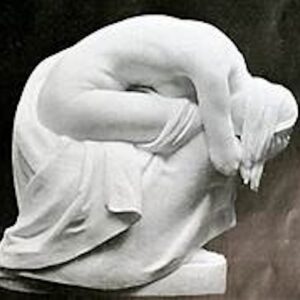“I’ve learned to pause from time to time…”
Me, too. Mindfulness practice.
The first foundation: mindfulness of the body. I’m typing. The shallow cups of plastic keys receive fingertips: that’s feeling. The letters arise, one after another, in Arial font on the screen: that’s seeing.
I’m reading: “Exposed stones like rows / of erupting teeth.” That, too, is seeing. “ExpOSed StOneS like rOwS / of erupting teeth mean walls / or rOadS….“ That’s hearing.
Grounded in physical sensation. Mindfulness of the body. So begins my experience of “Pausing on a Hillside in Anatolia” by Enid Shomer, a poem in her powerful new book, Shoreless.
What draws the speaker’s attention to these stones, these ruins, is history: a “landscape riddled with antiquity” that teaches (“I’ve learned”) the speaker to pause and notice. Present moment experience includes knowledge of the past. Sometimes, say for those of us who happen to be white, we may be ignorant of the presence of history, in this case the history of race in America, in our perceptions and actions. But in this poem, we’re in Anatolia.
And that’s where “the sound begins.” Mindfulness of hearing. What sound? Here again the poem pauses. Instead of jumping ahead to disclose the source of sound, which is revealed to the speaker soon enough, the poem offers us an experience of what the mind does when it encounters an unknown.
…in the distance, so faint at first I mistake it [the sound] for leaves spooling in the breeze . . . … It grows louder, from the jingle of coins in an army of pockets to nuggets of ore riding the rim of a prospector’s pan, shells churning in surf, the furious tinkling of icicles in a storm
The mind tosses up a proliferation of possibilities, each offering its own sensory pleasure. Still, the mind remains unsettled. Until it can definitively identify the sound, name it, contain it, and in so doing gain some control over it, the mind must seek comfort in another way.
…I used to pause like this, feeling called, when the college carillon tolled at dusk, hurrying me to my room….
I’ve had an experience like this before, the speaker says. I heard, and I paused. And though that carillon called her to hurry back to her room, in the sound of those giant chimes, which she could notice only because she paused and paid attention, she
…heard what I often
felt in my heart—
how wide is the gulf
between speech and silence, how sad our thoughts,
forever caught between.
Noticing thoughts as thoughts: that’s another of the four foundations of mindfulness, mindfulness of thinking.
Physical sensation—seeing and hearing—brings her back to the present moment.
…Now a goatherd appears with his goats, a patchwork of grays and browns that billows down the knoll, the bells on their necks resounding
In response to the delightful, enrapturing sound of the bells, desire arises—the desire to possess that music. So, the speaker tells us, even in the moment of representing her experience of enjoying the bells, that later, in a bazaar and market, she
will try to buy the music, hefting and sorting bells by shape and size, but nothing will match these starbursts of sound.
The poem’s tracking of experience—mindfulness of the body, mindfulness of thoughts, mindfulness of emotions (desire, sadness, disappointment)—continues. Following another immersion in the sound of the goats’ bells—”the accidental music…covers / me completely, a blanket woven / of thrums and spangles, glissando trills”—, the mind offers up another memory, this one of an earlier experience of full immersion in music. Here she recalls singing in a choir, when she felt
the bones of my skull buzzing, music passing through them like drone strings, my own voice inaudible in the rainbow of sound we hung from the rafters. I had to hold hands with the girl beside me for the highest soprano riffs, I was so dizzy with the bliss of blending in.
Singing in the choir drew her deeply into her embodied self (“the bones of my skull buzzing”) and at the same time carried her beyond her self (“the bliss of blending in”).
As with all things, fleeting as they are (think “impermanence”), the speaker’s experience of deep connection to the music of the goats finally comes to an end. When, having continued on their way, the goats could no longer be heard, the speaker strains
…through the new silence for any whisper, but even their hooves fall like felt on the stone outcrops.
Just as the mind cannot easily dwell in uncertainty, so the heart does not easily rest in grief, in this case pain caused by the loss of beauty. So, the urge to prevent the absolute loss of the experience is expressed in one more way in the poem.
“Years ago, I read // The Lives of the Romantic Poets.” Their “favorite toy / and metaphor for the poet,” the speaker recalls, was the Aeolian harp.
…Shelley believed the poet is like the wind harp, and life the wind that plucks his harmonies, his poems.
Alas, the speaker finds little comfort in Shelley’s metaphor.
…Well I have lived in a punishing wind for years now, but how many bells could I summon? Never enough for the century’s slaughter. Not even enough to forge the iron of my own losses into a sounding shape. After the goats sang to me in my language, I asked myself how I could live without that sound, though later it faded. Later, I could not even remember their music without this poem.
What is poetry? A response to an inescapable truth of human experience: loss. A response to being called—be it by carillon bells or bells hung around the necks of goats. What is poetry? A sound itself, music that calls us to pause and pay attention. What is poetry? A precise tracking of the movements of mind and heart in response to sensations—physical, mental, emotional.
Our Anatolia is here, now, wherever we are at this very moment. A wind is blowing, a bell is sounding. In my present moment experience, I hear the click of a mouse. I see the blinking of a cursor. In response to Enid Shomer’s music, I’m making something. It’s not enough to take the place of the captivating sounds of her poem. It’s not even a poem. But, in this case at least, I have her poem to return to, again and again, which continues to make its music, the music of life clearly heard and seen.
Richard Chess directed the Center for Jewish Studies at UNC Asheville for 30 years. He helps lead UNC Asheville’s contemplative inquiry initiative. He is a board member for the Center for Contemplative Mind in Society. He’s published four books of poetry, the most recent of which is Love Nailed to the Doorpost. You can find him at http://www.richardchess.com





